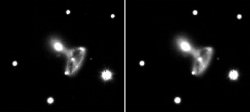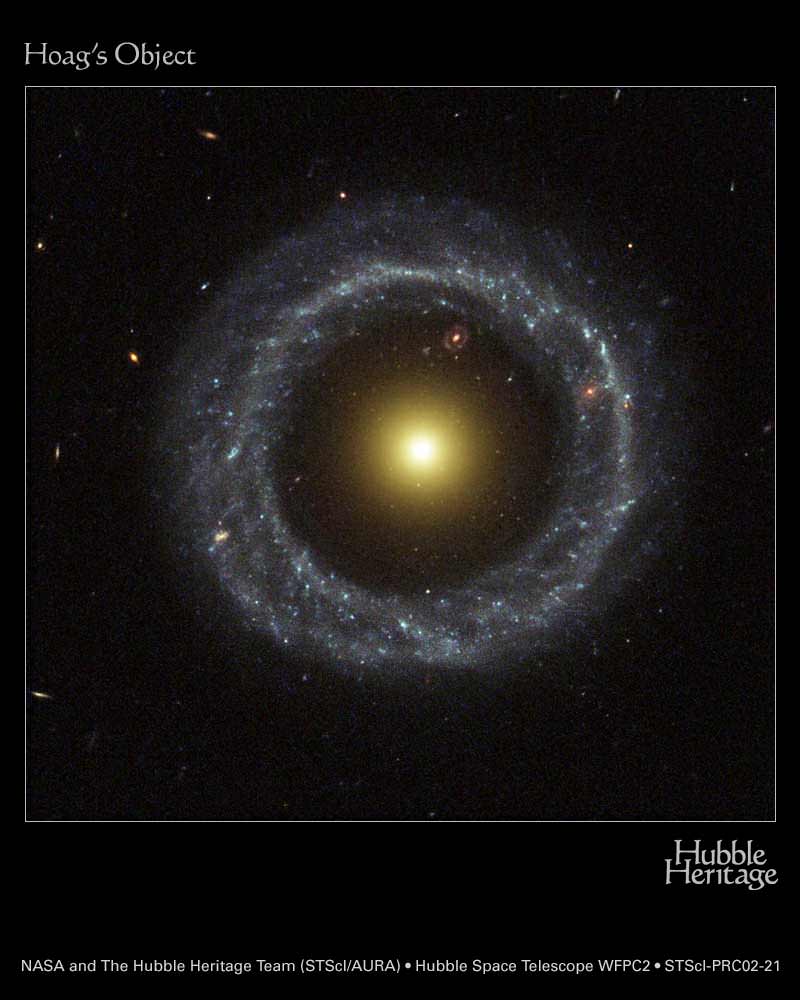[/caption]
One of the strangest types of galaxies are those known as ring galaxies. Examples of these include Hoag’s Object (shown above), the Cartwheel Galaxy, and AM 0644-741. These unusual shapes are cause by a galactic collision in which a smaller galaxy plunges nearly straight through the center of a larger galaxy. The gravitational disturbance caused a wave of star formation to ripple out from the center. In most cases, the intruder galaxy is long gone, but a serendipitous discovery as part of a larger survey recently turned up another of these objects, this time with the collisional partner still making its getaway.
Prior to this discovery, astronomers recognized only 127 ring galaxies, most of which are in the relatively nearby universe (< 1 billion lightyears). The lifetime of the ring structure is generally short lived and will dissipate once the density wave leaves the galaxy but while it persists, such galaxies give astronomers a wonderful chance to study the star formation the process triggers. In particular, it helps astronomers understand stellar evolution since the age of the stars becomes linked to the radius from the center; the newest stars are the furthest out where the ring is currently condensing new ones from the interstellar medium, and older ones lie towards the center where the density wave began.
The new ring galaxy was discovered by astronomers from the Max Planck Institute for Astronomy in Germany as part of a study to explore the Milky Way’s thick disk. The discovery images were taken in 2007 using the recently damaged Subaru telescope.

When the team noticed the rare galaxy in their image they tentatively dubbed it “Auriga’s Wheel”, they turned to the Gemini North telescope to obtain spectroscopy for the object. The redshift of these objects would allow astronomers to explore their distance and confirm that they were likely interacting and not simply a chance alignment. When the data was analyzed, the galaxies were found to lie together at a distance of nearly 1.5 billion lightyears making this a new record holder for furthest ring galaxy for which spectroscopic data has been obtained.
But aside from the temporary place in the record books, the pair is interesting in other ways. Modeling of the interaction as well as the spectroscopic data allowed the team to estimate the propagation of the ring to be at ~200 km/sec which would make it 50 million years since the collision occurred. The image also clearly shows the galaxy that plunged through the center of the more massive, disk galaxy and a distinct trail of gas and dust connects the two. Additionally, both galaxies appear to have Active Galactic Nuclei, which is rare for ring galaxies. However, it is not clear whether the activity was a result of the collision or a property of the individual galaxies prior to the interaction.


Very interesting article and pictures. The universe continues to amaze. One small picky point, it is not 50 million years since the collision, it is 50 million years plus 1.5 billion years.
Very interesting article and pictures. The universe continues to amaze. One small picky point, it is not 50 million years since the collision, it is 50 million years plus 1.5 billion years.
It’s a joystick!
And that intruder is like a bullet, that goes through, which is kinda surprising.
Ok Xperts,what happens to a ring Galaxy once its nuclei is gone? Does it continue to rotate around what used to be the center of the Galaxy or does its rotation decay and collapse or does it spin off into the vastness of interstallar space?
What would cause the nucleus to disappear? It does not vanish, and the mass of the nucleus largely remains there, with a small bit radiated out in the form of EM radiation.
LC
Thanks to you too sir.
As lcrowell points out, the nucleus in collisional ring galaxies do not vanish, but it some cases they may *appear* to disappear.
Arp 147 is one such case: http://imgsrc.hubblesite.org/hu/db/images/hs-2008-37-a-full_jpg.jpg
In Arp 147, the collision between the two galaxies was probably off-center and inclined somewhat from the perpendicular: http://arxiv.org/PS_cache/arxiv/pdf/1105/1105.4423v1.pdf
This in turn acted to displace the nucleus from the center of the blue star-forming ring (formerly a regular disk galaxy) and position it in the ring itself, here in the lower left quadrant. While this scenario is still speculative, other observations support this view (see linked paper and refs therein). In many cases, ring galaxies with a “missing”, displaced or offset nucleus are thought to have formed in a similar manner (off-center encounters).
Also, the blue star-forming ring in Arp 147 is observed to be expanding at over 100 km/s.
Thanks so much for the response and links. This is exactly what I was seeking. I am overwhelmed with the possiblities of the Universe and you folks on this site are exponentially more intelligent in this science than me. Appreciate your openess to teaching those of us that are reading (many years) but have nothing to offer through commentary!